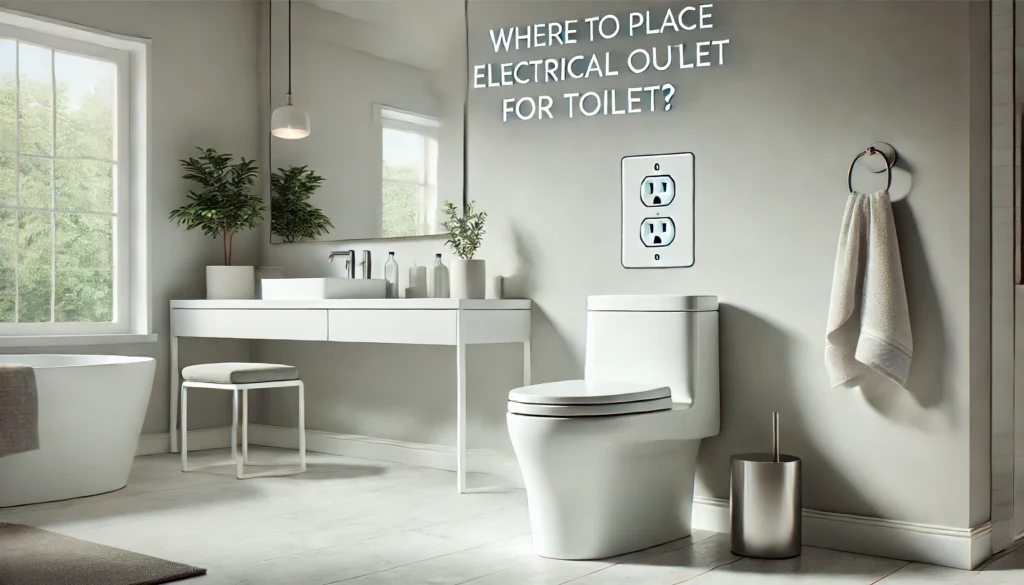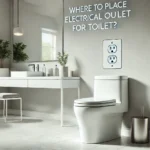Electrical outlet for toilets serve a variety of essential functions, including powering bidets, heated toilet seats, and cleaning systems.
Proper placement of electrical outlet for toilet is crucial for safety, convenience, and compliance with electrical codes. In this guide, we’ll delve into everything you need to know about where to place an electrical outlet for toilet.
Table of Contents
Why Electrical Outlet Placement for Toilets Matters
1. Functionality and Convenience
A well-placed outlet in a toilet room is crucial for optimal functionality and convenience. Modern features like bidet seats, seat warmers, and self-cleaning mechanisms rely on power sources for seamless operation. An accessible outlet enhances the user experience, while a poorly placed one can lead to inconvenience.
2. Safety Compliance
Electrical Outlet Placement in high-moisture environments like bathrooms is critical for safety standards compliance. Improper placement can lead to severe electrical hazards and potential risks.
Adhering to safety standards ensures that electrical outlets are positioned safely, minimizing risk. Prioritizing safety compliance and careful outlet placement safeguards us from electrical hazards.
3. Aesthetic Considerations
Appearance and clutter are key factors in outlet placement. Visible wiring can mar the bathroom’s look, while poorly placed outlets can limit fixture placement. Strategic outlet placement minimizes visible cords and creates a clean, sleek look.
Factors to Consider When Choosing Electrical Outlet for toilets
1. Type of Toilet
The type of toilet you choose will influence outlet placement. Standard toilets typically need one accessible outlet near the rear. However, bidet seats or smart toilets require additional outlets.
If retrofitting, consider existing outlets and plumbing. You may need an electrician to add or relocate outlets.
2. Code Requirements
Adhering to local electrical codes and regulations is crucial when planning outlet placement. The National Electrical Code (NEC) mandates the installation of Ground Fault Circuit Interrupters (GFCIs) in specific areas.
These devices are designed to protect against electrical shock. GFCIs must be installed within 6 feet of a sink, shower, or bathtub.
3. Bathroom Layout
Strategic outlet placement is crucial for both convenience and safety in bathroom design. Consider the location of your toilet, vanity, and other fixtures.
Outlets near the vanity are essential for powering grooming devices, while outlets near the walls can accommodate lighting fixtures and other electrical needs. Prioritize safety by avoiding outlet placement near water sources.
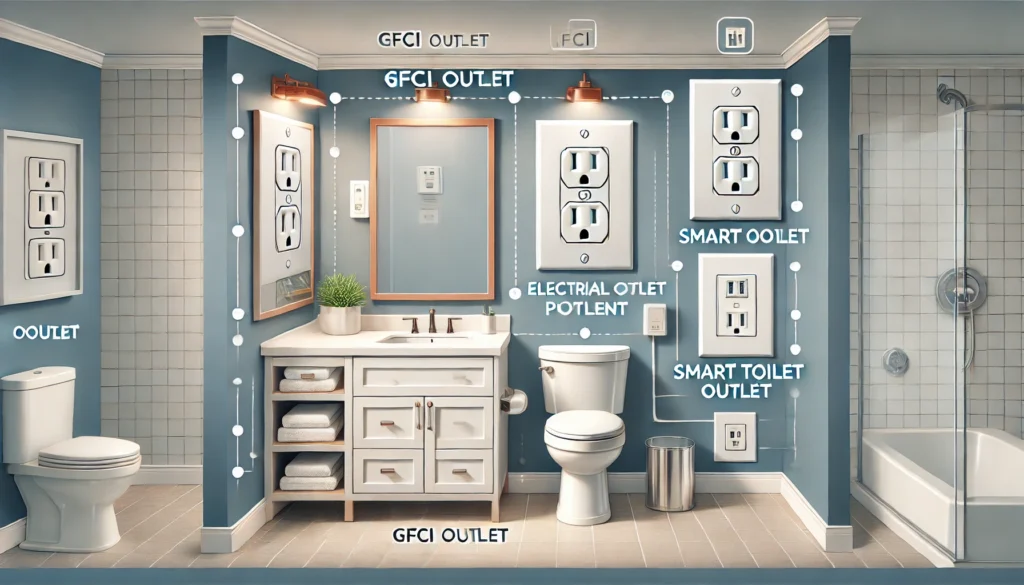
Recommended Placement of Electrical Outlet for Toilets
1. Behind the Toilet
A common and preferred option for outlet placement in toilets is behind the fixture. This position often offers the most convenient and least obtrusive location for plugging in devices.
To ensure proper height and avoid interference with plumbing connections, the outlet should be offset to the side of the toilet’s centerline. Typically, a height of 48 inches from the floor is recommended for this placement.
2. Beside the Toilet
A practical placement for an electrical outlet in a bathroom is beside the toilet. This location is ideal for powering toilet bidets, smart toilet seats, night lights, or fans.
While retrofitting an outlet here might involve wiring and rerouting cables, it’s often feasible, especially during a bathroom renovation.
3. Within a Cabinet
Built-in outlets concealed within vanity cabinets provide a sleek, clutter-free solution for powering bathroom devices. By strategically placing outlets inside the cabinet, you can hide unsightly cords and maintain a visually appealing space.
However, ensure the outlet’s location doesn’t obstruct airflow to prevent overheating.
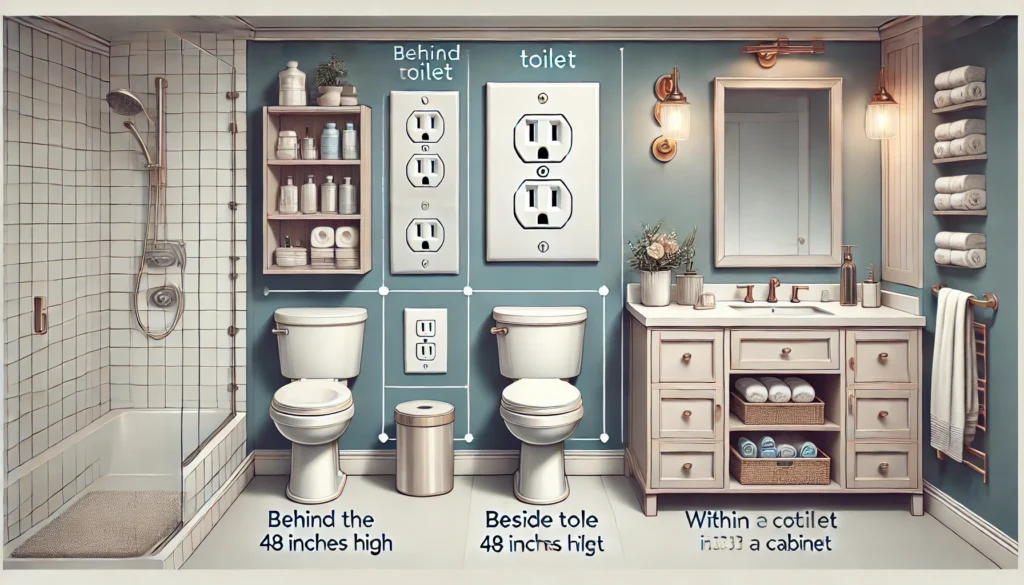
Key Safety Considerations
1. Use of GFCI Outlets
To ensure maximum protection from electrical shock, especially in wet environments like bathrooms and kitchens, GFCI outlets are essential. These specialized outlets continuously monitor the electrical current and rapidly interrupt the power supply in case of a dangerous imbalance.
2. Distance from Water Sources
Distance is crucial for safety. Fixtures like sinks, bathtubs, and showers should be far enough from water sources to minimize risk. Adhering to NEC guidelines for distance can prevent electrical accidents.
3. Moisture Protection
To extend the longevity of your outlet in humid conditions, use moisture-resistant outlet covers. These covers shield the outlet from moisture, reducing electrical risks.
Step-by-Step Guide to Installing an Outlet for Your Toilet
1. Plan the Placement
Before installing your toilet or bidet seat, check the manufacturer’s specifications for specific electrical requirements. This includes voltage, amperage, and wiring configuration.
Smart toilets and bidet seats often have additional electrical components, so pay close attention to these details. Ensure you have the necessary tools and materials, such as electrical outlets, junction boxes, wiring, and GFCI outlets.
2. Turn Off the Power
Before you start, it’s essential to power down the bathroom circuit. Locate your home’s breaker panel and switch off the breaker controlling the bathroom. Use a voltage tester to verify the power is off.
3. Install the Electrical Box
Locate and mark the ideal spot for your recessed outlet box on the wall. Cut a hole in the wall to accommodate the box. Mount the box securely to the wall studs, ensuring it’s level. Feed the cord of your toilet’s plug through the knockout hole in the box.
4. Run the Wiring
Safety is key when working with electricity. Turn off the main bathroom circuit before starting. Fish the electrical wires through the wall to the outlet location. Ensure proper grounding for safety.
5. Install the Outlet
Safety first. Shut off the circuit breaker controlling the outlet. Connect the wires: black to hot, white to neutral, and bare copper to ground. Tighten the connections. Secure the outlet box to the wall. Attach the cover plate.
6. Test the Outlet
To verify the outlet’s functionality, use an electrical tester. Insert the tester’s prongs into the outlet’s slots. If the tester’s lights illuminate, power is present. If not, double-check connections and the circuit breaker.
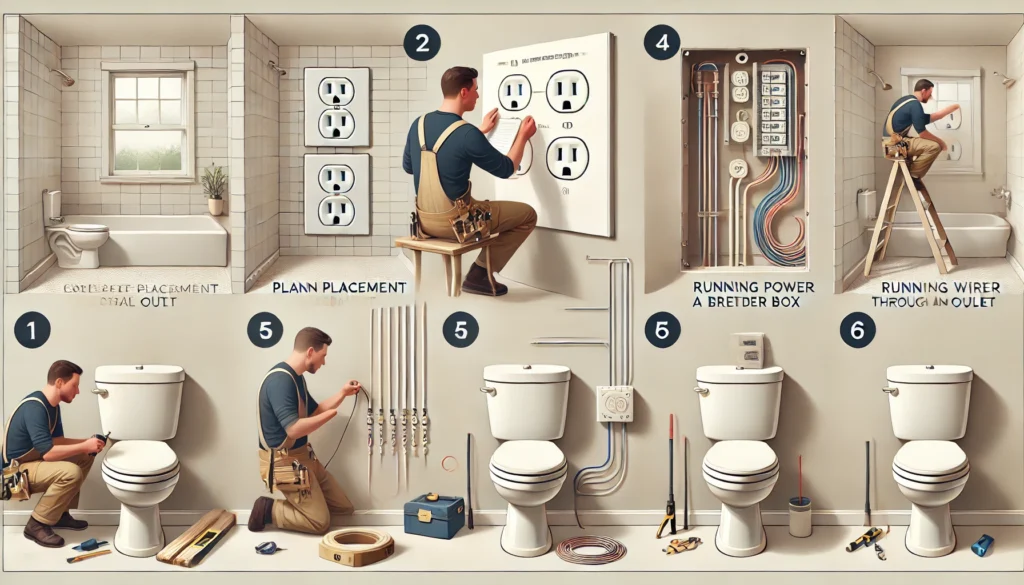
Common Mistakes to Avoid
1. Placing the Outlet Too Low
Proper outlet placement is crucial to avoid future water damage and inconvenience. Installing an outlet too low increases the risk of water exposure, especially during cleaning or accidental spills.
This can lead to damage to the floor and surrounding areas. To prevent such issues, ensure the outlet is positioned at an appropriate height, typically around 18 inches above the floor.
2. Ignoring Future Needs
When installing a new toilet outlet, consider the future and potential upgrades. By investing a little extra time and money, you can prepare for a smart toilet or bidet seat. This will save you from costly renovations later.
3. Overlooking Code Requirements
Ignoring local electrical codes can result in serious safety hazards and hefty penalties. Before starting any electrical project, including toilet outlet installation, it’s crucial to verify compliance with local regulations. A licensed electrician can ensure adherence to these codes, preventing potential risks and legal issues.
Professional Installation vs. DIY
While attempting to install electrical outlets in a toilet might seem like a DIY project, it’s crucial to consider the safety and compliance aspects. Licensed electricians are trained to adhere to local codes and standards, ensuring that the installation is safer and more reliable.
For those unfamiliar with electrical work, DIY attempts can lead to potential hazards and costly mistakes. By entrusting the task to a professional, you can have peace of mind knowing that the job is done right.
Check Similar Guide: How Long Should Toilet Refill Tube Be? A Comprehensive Guide!
Conclusion
When planning a bathroom renovation or new construction, careful planning is crucial to ensure optimal functionality and safety. One key consideration is the placement of electrical outlets.
By strategically positioning these outlets, you can enhance the overall bathroom design while adhering to code requirements.
Prioritize safety by keeping outlets away from water sources and installing GFCI (Ground Fault Circuit Interrupter) outlets in areas prone to moisture, such as near sinks and bathtubs.
To accommodate modern bathroom features like electric shavers, hairdryers, and other appliances, consider installing multiple outlets in convenient locations.
Think about future needs and plan for potential upgrades, such as smart home devices or additional lighting fixtures. While functionality is paramount, don’t overlook aesthetics.
Choose outlets that complement your overall bathroom design and are practically placed to avoid unsightly cords and wires. By following these guidelines, you can create a bathroom layout that is both functionally and aesthetically pleasing.
Frequently asked Questions
What is the ideal height for a toilet electrical outlet?
The ideal height for a toilet electrical outlet is between 12-18 inches from the floor. This height ensures the outlet is easily accessible while staying clear of plumbing and floor-level moisture.
Does the outlet need to be GFCI-protected?
Yes, any outlet installed in a bathroom must be GFCI-protected to comply with safety codes. GFCI outlets reduce the risk of electrical shock in wet environments by shutting off power during a fault.
Can the outlet be placed behind the toilet?
Yes, placing the outlet behind the toilet is a common practice. However, it should be slightly offset to the side (about 6 inches from the toilet’s centerline) to avoid interference with the water supply line and drainpipe.
How far should the outlet be from the toilet?
The outlet should be positioned close enough for the toilet’s power cord to reach, typically within 12-18 inches. Avoid placing it so close that it interferes with plumbing or makes maintenance difficult.
What are the electrical code requirements for toilet outlets?
Electrical codes, like the NEC, require bathroom outlets to be GFCI-protected and placed at least 6 feet away from bathtubs and showers. Always consult local building codes for additional requirements.
Can the outlet be installed inside a cabinet near the toilet?
Yes, outlets can be installed inside cabinets for a cleaner look. Ensure the cord can easily reach the toilet and that there’s adequate airflow to prevent overheating.
Can I install the outlet myself?
You can install the outlet yourself if you are knowledgeable about electrical work and local codes. However, hiring a licensed electrician is recommended to ensure safety and compliance.
What type of outlet should be used for a toilet?
Use a standard 15-amp or 20-amp GFCI outlet. Check the toilet manufacturer’s requirements to ensure the outlet can handle the electrical load.
Should the outlet be moisture-resistant?
Yes, in high-humidity areas like bathrooms, it’s advisable to use moisture-resistant outlet covers or weatherproof enclosures for added protection.
Is it safe to place the outlet near a water source?
Outlets must maintain a safe distance from water sources like sinks, showers, and bathtubs, typically at least 36 inches. Ensure the outlet is also GFCI-protected to mitigate risks.
Do all toilets require an electrical outlet?
No, only advanced toilets, such as smart toilets or bidet seats, require electrical outlets. Standard toilets typically do not need one unless retrofitting with powered accessories.
What happens if the outlet placement is wrong?
Improper outlet placement can lead to inconvenience, safety hazards, or code violations. It may also make it difficult to use the toilet’s features or require costly relocation later.
Can the outlet be placed on the floor?
Placing outlets on the floor is not recommended due to increased risk of water exposure. Always install outlets on walls or within cabinetry for safety.
Should I consider future upgrades when placing the outlet?
Yes, it’s wise to plan for future upgrades like smart toilets or bidet seats. Even if you don’t need an outlet now, installing one during construction or renovation can save time and money later.
How do I hide the cords and outlet for a cleaner look?
To hide cords and outlets, consider recessed outlet boxes or placing the outlet inside a nearby cabinet. This approach minimizes visible wiring and creates a more streamlined bathroom appearance.

